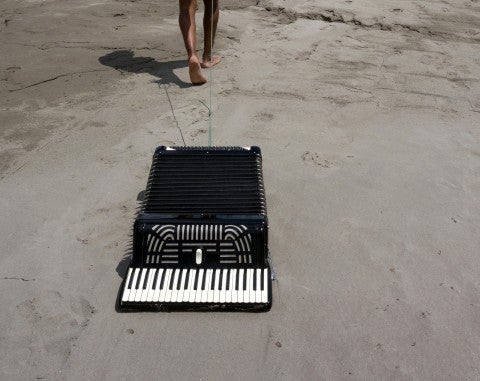By naming themselves Los Jaichackers (Spanglish for hijackers), the multimedia duo of Los Angeles–based artist Eamon Ore-Giron and Phoenix-based artist Julio César Morales signaled the modus operandi of their artistic project. They investigate the many ways in which cultural forms, in particular music, have been hybridized through hijack—that is, produced from being taken over and inscribed with new meaning for different purposes. A hijack typically has a negative connotation, but Los Jaichackers suggest it can be a fruitful, generative practice in their videos; record label (Discos Unicornio); and presentations of experimental music, lectures, and performances at institutions, including the Perez Art Museum Miami, SF MoMA, Los Angeles County Museum of Art, and the Prospect.3 Biennial that demonstrate its potential.
Their first project was Migrant Dubs (2006), an installation in the form of a 10x10–foot mirror-covered cube that visitors can enter then watch videos of street musicians performing cover songs of American music recorded and remixed by Los Jaichackers. The musicians come from various locations across the United States and Mexico, and the videos reflect the informal, underground ways people creatively reinvent music in their own styles and often as a means of survival. Seventeen years later, Los Jaichackers followed up Migrant Dubs with Psychomagic (2023), a work featuring videos from the original piece and a sculptural installation of text-based elements featuring rótulos, Mexican hand-painted street signs.
The video Subterranean Homesick Cumbia_Remix (2018) visualizes the process of assigning new meaning to an object as the camera follows the journey of an accordion across a landscape into new spaces. The work traces the mythic origin of Cumbia, which is considered Latin America’s first hybrid musical genre. Legend says in the mid-1800s a German merchant ship crashed on the shores of Colombia, spilling its cargo of accordions. The instruments were retrieved by local communities and enslaved people who incorporated them into their musical tradition to form a new vernacular sound.
Los Jaichackers portray the arrival of the accordion. It hangs from trees, floats in the water, sits atop a mound of sand, and drags across the beach like found treasure. While its sonic qualities become more integrated into the fabric of daily life—suggested by the Cumbia soundtrack and the views of albums inside a music store, when it appears on a crate by a fruit stand and damaged in an abandoned courtyard—the aesthetic curiousness of its form is underscored. The accordion as an object takes on new social, cultural, economic, and political meanings as it is pulled and placed into various spaces. In this Caribbean context, it figures as more than a musical instrument, evoking histories of survival and resilience based on strategies of reinvention and adaptation, not only in music but also in food, language, dress, and more. Like the underground informal economies that have interested Los Jaichackers for nearly twenty years, the reinvention of the accordion in Cumbia and the Caribbean reflects the vital history of the hijack. –Kanitra Fletcher

